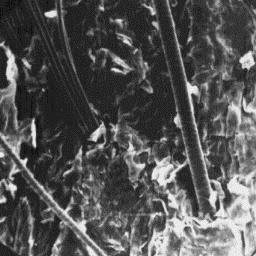 Paradoxurus hermaphroditus
Paradoxurus hermaphroditus
--------------------------
English: Common palm civet
German: Fleckenmusang
French: Civette palmiste
hermaphrodite
Spanish: Civeto
Distribution areas
------------------
The common palm civet lives in
South-East Asia, mainly in southern parts
of China, in Sri Lanka, Malaysia and the
Philippines.
Description of the fur The surface structure
---------------------- of the skin, 200x
The skins are from 45 to 55 cm long; the
tail is between 41 and 51 cm long. The coat is soft and dense, and about 15 mm
thick. The colour of the underfur layer is grey while the upper part of the
coat is much lighter. Over the body are dark-grey or black spots. The back,
head and the ends of the legs and the tip of the tail are of a black
coloration of the coat.
|
|
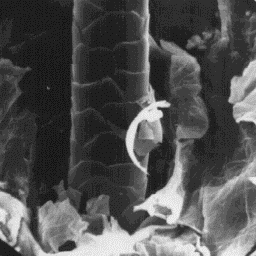 Paradoxurus hermaphroditus
Paradoxurus hermaphroditus
--------------------------
English: Common palm civet
German: Fleckenmusang
French: Civette palmiste
hermaphrodite
Spanish: Civeto
Structure of the hair
---------------------
The microscopic skin surface structure
appears furrowed. The hair follicles are
narrow with straight edges. The average
follicle contains small cluster of the
fibres.
The cuticular structure
The fine fur fibres are circular, and in of the fine fibres, 1000x
the upper part of the hair shaft also
elliptical, in cross-section. The diameter is in the range of 8 to 14 µm. The
cuticular scales are cornet-like with a smooth surface and straight scale
margins. These fibres have a wide, unbroken, central symmetrical-shaped
medulla which is of the uniserial ladder type with a granular and an amorphous
infilling substance.
|
|
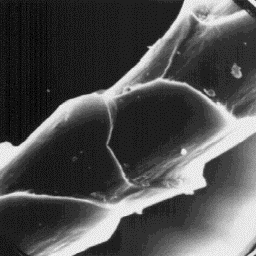 Paradoxurus hermaphroditus
Paradoxurus hermaphroditus
--------------------------
English: Common palm civet
German: Fleckenmusang
French: Civette palmiste
hermaphrodite
Spanish: Civeto
The intermediate fibres have a circular,
and in the middle and upper parts of the
shaft elliptical, cross-section with a
diameter of about 16 to 27 µm. The cuticle
is cornet-like at the lowest part, and
rounded tile-like in the middle and upper
parts, of the shaft. The cuticular scales
have a smooth surface and straight margins. The cuticular structure
The medulla is wide, unbroken and of the of the fine fibres, 4000x
central symmetrical type. The overall
structure of the medulla is of the uniserial ladder type with an amorphous and
sometimes a granular type also of infilling material.
The guard hairs are from 25 to 35 µm in diameter. These fibres are
elliptical in cross-section. The cuticular scales are of the even, tile-like
shape with a smooth surface and straight scale margins. The medulla is wide,
unbroken, and central symmetrical-shaped and is of the uniserial ladder type
with a granular or an amorphous structure to the infilling substance.
|
|
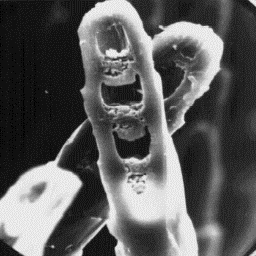 Paradoxurus hermaphroditus
Paradoxurus hermaphroditus
--------------------------
English: Common palm civet
German: Fleckenmusang
French: Civette palmiste
hermaphrodite
Spanish: Civeto
Transverse section
of a fine fur fibre, 2000x
|
|
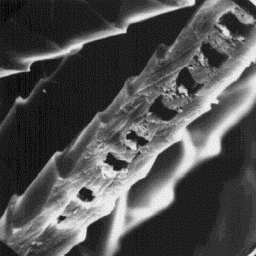 Paradoxurus hermaphroditus
Paradoxurus hermaphroditus
--------------------------
English: Common palm civet
German: Fleckenmusang
French: Civette palmiste
hermaphrodite
Spanish: Civeto
Longitudinal section
of a fine fur fibre, 2000x
Numerical code for common palm civet skin surface
-------------------------------------------------
Surface of the skin: 3-4-3
Fine fur fibres: 1.2-5-1-1-2-1-1-1-6.8-8.14-6.11
Intermediate fibres: 2.1-3.5-1-1-2-1-1-1-6.8-16.27-8.15
Guard hairs: 2-2-1-1-2-1-1-1-6.8-25.35-10.18
|




